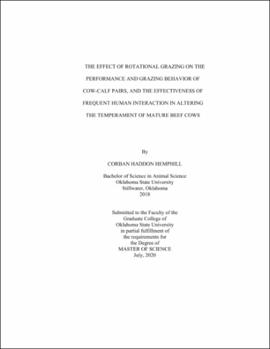| dc.description.abstract | The objective of this study was to evaluate several of the reported benefits attributed to rotational grazing. Rotational grazing (R) was compared to continuous grazing (C), and grazing behavior, forage and diet quality, and forage production were analyzed. The stocking rate in C was 27% greater than in R. Using GPS collars attached to cows, uniformity of grazing distribution, distance traveled, mean distance to water, time spent near water, daily area explored, and the spatial search pattern was analyzed. Grazing method did not affect grazing distribution (P > 0.23). Time spent near water, mean distance to water, and distance traveled per day were also unaffected by grazing method (P > 0.12). The daily area explored was greater in the C treatment (P = 0.02), and spatial search pattern was greater in the R treatment (P = 0.01). Grazing method had no effect on forage utilization (P = 0.64), or NDF content of forage (P > 0.25). Forage production differed only in May, with C producing more kg/ha of forage (P = 0.06). Forage crude protein differed only in July, with C having greater crude protein (P = 0.05). Both ADF and lignin differed in May and December, with C having greater values for both (P < 0.10). Diet quality was greater in C (P < 0.07). No difference was found between grazing treatments in body condition score (P > 0.13), calving rate (P = 0.11), percentage of weaned calf weight to cow body weight (P = 0.23), or kg of calf produced per ha (P = 0.17). Calf weaning weights were greater in C (P = 0.04). Cow body weights were greater in the continuous treatment in October only (P = 0.06). Rotational grazing methods require more frequent human-animal interaction than does continuous grazing, benefiting animals with less excitable temperaments. An additional study was conducted evaluating the effectiveness of acclimating mature Brahman x Angus F-1 cows to human interaction to improve their temperament. No difference was found in chute score (P = 0.13) or chute exit velocity (P = 0.63) when cows in the positive human interaction treatment were compared to the control treatment. Cows in the positive human interaction treatment tended to have lower alley scores (P = 0.05). The specific type of human acclimation implemented did not consistently affect cattle temperament, indicating other traits may be more important in determining temperament or other acclimation procedures may be more effective at altering temperament. | |
